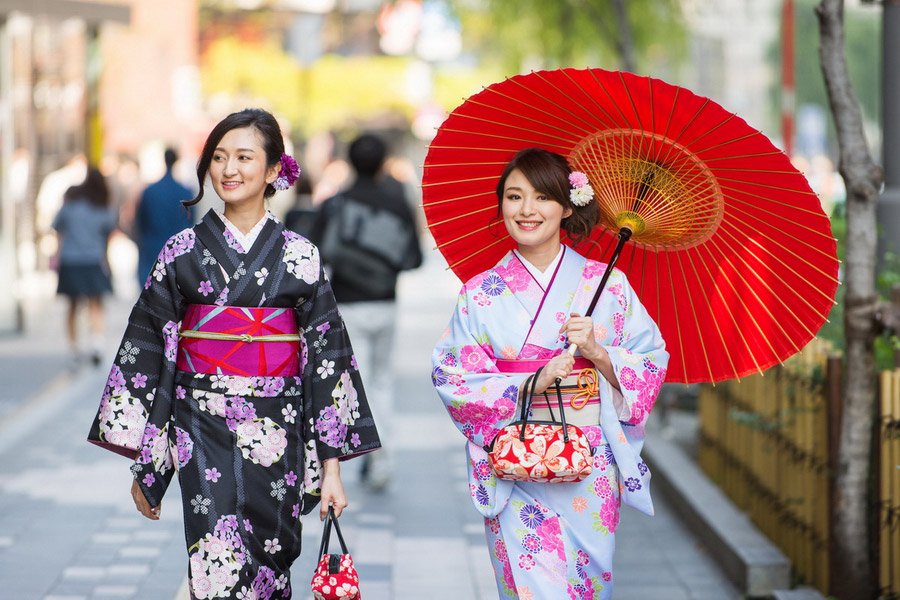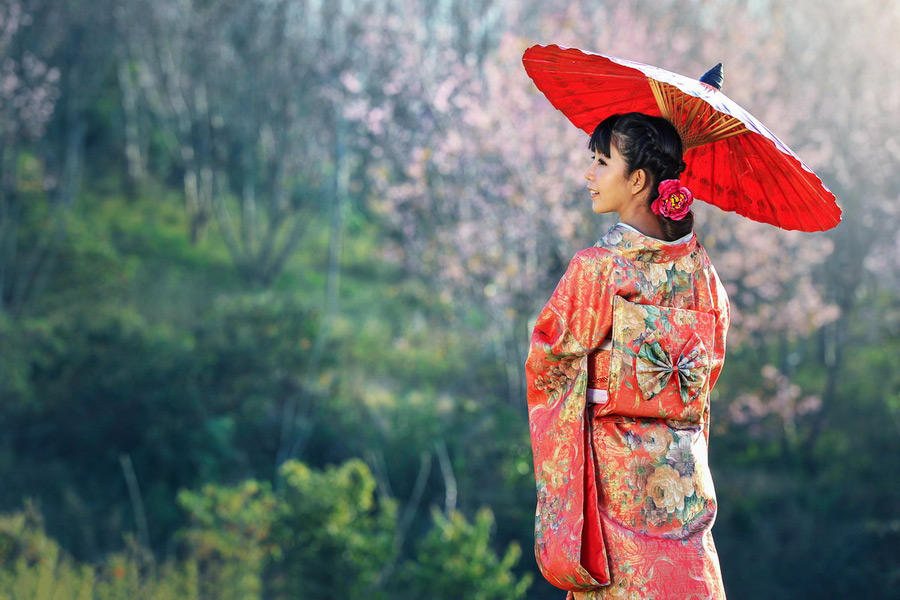
The kimono is one of the most recognizable symbols of Japan. This traditional apparel has a rich history and profound meaning.
If you are visiting Japan for the first time, it's important to understand that the kimono is not just a stylish robe; it is also a key to understanding Japanese culture and philosophy.
What Does a Kimono Symbolize?
The kimono is a symbol of respect for Japanese traditions. In the past, every detail in the kimono, from how a person wore it (kitsuke – “dressing”) to selecting a particular motif and color, had a unique meaning, revealing the class and rank of the kimono owner. Nowadays, people choose colors and designs they like without considering the meaning behind them.
Although worn sparingly today, a kimono remains a vital component of Japanese culture. The Japanese typically reserve it for special occasions such as weddings, funerals, tea ceremonies, celebrations, and festivals. Geisha and maiko, as part of their profession, are required to wear kimonos. Besides, many fashion professionals offer contemporary interpretations of this traditional garment.
Wearing a kimono is more than a fashion statement; it is a way to honor Japan’s historical and cultural roots.
The Kimono History

A kimono (lit., “a thing to wear”) was traditionally worn by people of all genders. Before the Meiji Era (1868 to 1912), what is now commonly referred to as “kimono” was known as “kosode”, meaning “small sleeve”. People usually wore it with hakama, skirt-like pants, and a belt. The kimono's style was influenced by Chinese fashion during the Nara period, but it didn't become the kimono we know today until the Heian period.
Unlike peasants, who wore plain kosode with basic patterns, members of the imperial court wore elaborately layered outfits. The colors and ornaments of the attire told everyone about the wearers’ rank, social status, age, and even specific circumstances and the season.
Between the 15th and 16th centuries, the kosode, once a silk undergarment with a robe worn over it, transformed into an outer dress for noblemen. Its design mirrored the might of prominent warlords like Oda Nobunaga, Toyotomi Hideyoshi, and Tokugawa Ieyasu. They adorned their attire with intimidating animal decorations, vibrant motifs, and family coats of arms embroidered with couched gold and silver threads.
The Kimono: A Window to the Edo Society
During the Edo period (1603 - 1868), the kimono style underwent several changes. While the nobility had dibs on glowing colors and fancy fabrics, the merchants made serious banks that led to a demand for luxury clothing. Even though they weren't as high up the social ladder as the samurai, the merchants had more cash and could afford to indulge in lavish attire. Consequently, the middle class began adopting bolder styles, completely transforming the fashion landscape.
As printing technology advanced, actors gained fame as fashion icons, showing off their exquisite tastes through performances and colorful woodblock prints called Nishiki-e - like the posters of modern movie stars and influencers. Kabuki actors and courtesans wore flashy and intricate kimonos that distinguished them from the general populace. Thanks to new color printing techniques, these woodcuts became more affordable, so even people who weren’t rich could get their hands on them; as a result, the mercantile classes picked up these trendy styles before the ruling classes. Fine examples of these prints can be found in "The World of Traditional Performing Arts: Kabuki, Bunraku, No and Kyogen, Gagaku, Kumi-odori" at the Tokyo National Museum.
During Japan's period of isolation, new techniques emerged, including yuzen dyeing. This textile dying mimicked the costly hand-painting process. As the ruling classes tried to regulate colors and materials, merchants found clever ways to circumvent these restrictions. They wore lavish kimonos beneath modest outer layers, revealing only a hint of color on the sleeve or hem to avoid exposing their wealth and style.
Kimono and Modern Japanese Fashion

During the Meiji era (1868–1912), Japan embraced international influence, sparking a modernization wave across various aspects of society. Clothes were no exception - the fashion scene experienced a blend of Japanese and Western styles, creating an exciting period. While men were particularly encouraged to adopt Western clothing, women also experienced changes in fashion.
Technological progress in the West brought new printing methods and synthetic dyes that produced brighter colors. During the Taisho and Showa periods, advancements in textile production, such as cheaper meisen silks, introduced eye-catching elements that are resurging in fashion today.
Young women are decking out in vintage haori (kimono jackets) with their jeans. Designers worldwide have also taken notice, infusing their collections with classic shapes and motifs from traditional Japanese clothing. For example, Alexander McQueen's avant-garde kimono for Björk, Thom Browne's kimono suit, and Christian Louboutin's silk platform shoes are notable examples of Western fashioners drawing inspiration from this timeless style.
Young Japanese couturiers are reimagining the kimono for a new generation with everyday variations on the theme – Hiroko by Takahashihiroko showcases graphic prints. At the same time, Tsukikagei offers punk-inspired options, breathing fresh life into this iconic garment.
The exhibition “Fashion in Japan 1945–2020” at the National Arts Center Tokyo explores the impact of kimono forms and techniques on modern Japanese fashion - from Hanae Mori's sophisticated use of yuzen patterns to Yohji Yamamoto's state-of-the-art fashion mongers of the 1970s and recent kawai (“cute”) trends.
Types of Kimonos
There are various types of kimonos, each with distinct characteristics and purposes.
- Furisode (“swinging sleeve”) is a kimono worn by young unmarried women. It has long sleeves and is brightly colored. This type of kimono is standard for the Coming-of-Age Day, a national holiday for those who have entered adulthood.
- Irotomesode (“color short sleeve”), mostly for married women, is characterized by a drawing along the hem on the colored background. Kurotomesode (“black short sleeve”)) is for formal events such as weddings. Mothers and relatives of the bride and groom are likely to opt for kurotomesode. The ornate design is also along the hem.
- Homongi translates as “visiting wear” and can be worn by women of all ages, single or married, at tea parties, weddings, etc. It comes with continuous depictions from the shoulders to the hem.
- Tsukesage can be easily confused with homongi. However, unlike the latter type, tsukesage’s motifs do not cross over the seams of the kimono panel and demonstrate fewer fluid motifs. Low-ranked women wore it at formal events.
- Komon, known for its “small patterns”, is a casual kimono worn by women, primarily before pre-war Japan.
- Iromontsuki is a common formal kimono for men to attend weddings and ceremonial occasions. It’s usually a black and silk-made robe mantled over hakama.
- Shiromuku, worn by brides in Shinto wedding ceremonies, is a traditional white silk kimono with long, flowing sleeves and a trailing skirt. It is often decorated with cranes and pine trees, symbolizing purity and innocence.
What Kind of Kimono is a Yukata?
The yukata, a great summer outfit for both men and women, is a simplified version of the traditional kimono with unique features. Unlike the traditional kimono, yukata is made from lightweight cotton or synthetic fabric, predominantly worn at summer festivals like matsuri and after bathing.
Another difference between yukata and kimono is the construction. Compared to the structured and layered kimono, yukata sleeves are short, and the overall fit is more relaxed and casual. Additionally, the yukata lacks the inner lining and multiple layers typical of kimonos, enhancing its comfort. It is often accessorized with a colorful obi sash and geta sandals.
Tourists in Japan often rent a yukata for strolling through the streets of Kyoto, thanks to its uncomplicated design.
Getting Kimono Experiences in Japan

If you're looking for an immersive experience in Japan, try getting into a kimono. You can find kimono rental shops in Kyoto, Tokyo, and Osaka. Search for "kimono rental" on Google or check out Airbnb or Booking.com.
When you arrive at the shop, you'll have a huge range of beautiful kimonos and casual yukatas to choose from. Don't forget to book in advance, especially during peak tourist seasons.
The rental normally includes the kimono or yukata, socks, sandals, and a bag. You can also opt to pay extra for makeup and hair styling services. To enhance your experience, rent traditional adornments like fans or umbrellas, or get a photoshoot to capture your special day.
Visiting Kimono Exhibitions
Strolling through Kyoto's streets adorned in a traditional kimono will undoubtedly offer both aesthetic delight and a lasting memory. However, for a meaningful immersion into kimono culture, consider exploring three notable locations: two museums and a textile center. The destinations below showcase elegant collections of Japanese traditional clothing, providing a deeper understanding of the kimono's significance and artistry.
Kubota Itchiku Art Museum
Mount Fuji's gorgeous views are best seen at Lake Kawaguchi in Yamanashi Prefecture. If you take a 10-minute walk north along the gradual slope from the lake's northeastern shore, you’ll reach a massive gate. It's the entrance to a museum built by Kubota Itchiku (1917-2003), a textile artist who brought back the lost art of silk dyeing for kimono, called ichiku tsujigahana.
Hours: 10:00 AM – 5:00 PM
Saturday, Sunday, Monday
Admission fee: 1500 yen
Ome Kimono Museum
Ome Kimono Museum in the Ome City of Tokyo Prefecture contains over 500 pieces of kimonos. It offers a unique peek into the fashion styles of feudal lords and imperial family members.
Hours: 10:00 AM – 4:00 PM
Friday
Admission fee: 600 yen
Nishiki Textile Center
Nishiki Textile Center in the Nishijin district of Kyoto, Japan, is a museum about the art of traditional Japanese textiles, particularly Nishijin-ori. The center arrays kimonos in vivid colors, Nishijin-ori textiles, and textile-making tools and techniques. You can learn about the history and significance of Nishijin-ori and observe artisans at work creating these beautiful textiles.
Hours: 10:00 AM – 4:00 PM
All days except Monday
Admission: free

